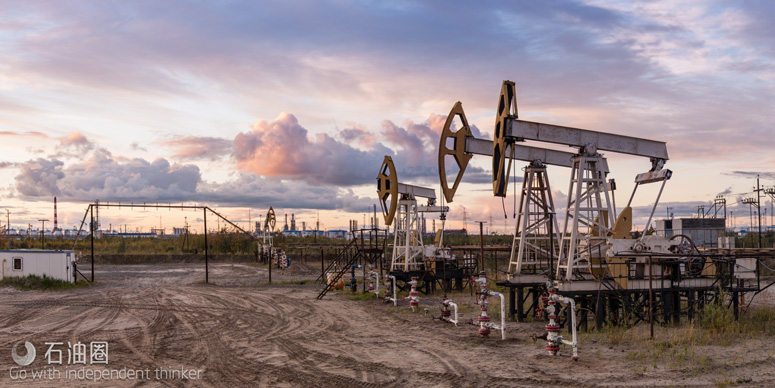
作为油市半边天,北美地区钻井商将2017年预算提高到840亿,在如此“高不成低不就”的油价下,他们为何这么做?油市又何时回稳?
作者 | Joe Carroll
编译 | 宁采臣 卡夫卡
北美钻井数十七连增
据油服贝克休斯公布的数据显示,截至5月12日,美国当周石油钻井总数升至712口,较上周增加9口,连续17周录得增加。该数据已经创2015年4月以来最高水平,与美国原油产量最高纪录仅相差2%。
根据摩根士丹利的数据,在过去一年中,如果按照头尾净增量进行周化平均的话,美国原油钻机数的增量达到了7.3台/周,超过了2009年页岩油气革命处于爆发期的钻机增速,创下过去30年最高水平。
北美钻井商狂增预算
另一消息称,北美钻井商计划将2017年的预算提高32%到840亿美元,而全球其他地区的钻探项目预算增幅只有3%。
预算大部分增幅将流入二叠纪盆地,这里的原油生产商在如今油价不足2014年高位一半的情况下也获得了两位数的回报。
Wood Mackenzie Ltd估测,新开支将使今年美国原油产量增加80万桶,约相当于沙特和俄罗斯领导的削减产量计划的44%。
Wood Mackenzie研究分析师Roy Martin在一次电视采访里表示:“美国页岩油气供应前景是真实的,其资本预算增加的幅度超出了我们的预期”。
迄今为止,EOG Resources和Pioneer Natural Resources等美国独立勘探商仍坚持他们雄心勃勃的增长计划。EOG首席执行官Bill Thomas在一次会议上向投资者和分析师介绍说,在第一季度的价格水平下,二叠纪盆地的部分钻井项目取得了70%的回报率。
根据Barclays分析师J. David Anderson表示,包括EOG和Pioneer在内的北美页岩钻井商今年的预算总额由2016年的350亿美元上升到530亿美元。EOG是美国第二大没有炼油厂的勘探企业,该公司计划将今年资本支出增加44%到37亿美元—41亿美元;Pioneer计划将资本支出提高33%到28亿美元。
虽然新钻井带来的原油产量增加,几个月内不能立马显现,但美国的原油产量已经开始膨胀。近日,美国能源部的统计部门提高了对2017全年的产量的预测,预计达931万桶/天,比4月份的预测增加了1%。预计,明年美国油田产量将达到996万桶/天,比上个月估计的产量还要多0.6%。
再者,美国总统特朗普已经签署行政命令,允许扩大海上石油钻探活动,这对美国石油行业而言无疑是一大利好消息。一旦该行政命令获得国会的批准,美国原油生产将迎来更大的产量。但在如今美国原油库存居高不下的情况下,这无疑让供需不平衡的市场雪上加霜。
抵御低油价的法宝
除了北美钻井商,美国和欧洲的石油巨头们却在追求截然相反的一条道路——削减今年的预算。随着深海石油项目、油砂项目和其他高成本、高风险的投资项目因为油价下跌而搁浅,他们严重受挫,不得不进行重组。
例如,荷兰皇家壳牌、雪佛龙、道达尔和英国石油公司计划缩减或维持2017年的预算,埃克森美孚作为唯一一个扩大预算的公司,其计划也仅仅是从去年的193亿美元提升至今年的220亿美元。
为何北美钻井商如此“愈挫愈勇”,在油价低迷期如此“违背常理”?
除了钻井成本的下降之外,还有两大原因。第一个原因,也是他们和油公司的一大不同之处,即页岩钻井商没有运营大型项目的负担,资金回流快,现金流压力较小,能够根据油价变化更快地做出反应。
另一个页岩钻井商很乐观的原因是,他们使用对冲手段减轻了自己压力。对冲是锁定未来原油价格的金融工具,它保护着生产商不受市场波动的影响。专家Martin称,虽然近期油价低迷,但美国独立原油生产商通过对冲保值进行了隔离。
OPEC的噩梦
由于全球原油市场暴跌,现金流减少,2016年的全球钻探预算也大幅减少,迫使勘探商取消扩张项目的计划、裁员并变卖油气田来获得现金。整个OPEC也备受打击,因此在去年11月与一些非OPEC国家达成了减产180万桶/天的协议。
OPEC减产协议曾推动油价一度大涨,油价曾蹿到55美元以上,但这也为北美钻井商带来了大量的现金。最近一段时间油价已经重新跌回50美元以下,反映了市场对于OPEC减产协议对抗美国页岩油猛增的悲观预期。
而OPEC最大的噩梦就是,非OPEC国家在油价为50美元的时候还能成功增加新的供应。
事实上,多年的低油价让美国页岩油生产商变得更高效,成本更低廉。专业分析师估计,只要油价保持在40美元/桶以上,美国生产商就能赚钱,这相比2014年的65美元大大降低了。
也就是说,当油价保持在40美元时,美国页岩油钻井仍可能会再增加,美国石油产量也会继续增加。
油市平衡还有戏吗
专家说,在美国页岩油产量、没有配额的OPEC国家以及其他产油国加足马力产油之际,即使OPEC将减产协议再延长6个月,对油市的平衡也可能也无济于事。除非OPEC加深减产幅度,而不只是拓宽宽度。
然而,即使是目前的减产量,也是经过了长达数月,经过三番五次的讨论下才达成的,让OPEC削减更多的产量,这几乎是一项不可能完成的任务。
最新消息称,俄罗斯能源部长Alexander Novak和沙特阿拉伯能源大臣Khalid Al-Falih在北京表示,支持将OPEC减产协议延长9个月,减产幅度维持不变,具体决定将在5月25日作出。此次延长减产协议能否顺利达成,协议能否使油价反弹至60美元/桶,从以往的情况来看,似乎不够乐观。
CHICAGO (Bloomberg) — U.S. shale explorers are boosting drilling budgets 10 times faster than the rest of the world to harvest fields that register fat profits even with the recent drop in oil prices.
Flush with cash from a short-lived OPEC-led crude rally, North American drillers plan to lift their 2017 outlays by 32% to $84 billion, compared with just 3% for international projects, according to analysts at Barclays Plc. Much of the increase in spending is flowing into the Permian basin, a sprawling, mile-thick accumulation of crude beneath Texas and New Mexico, where producers have been reaping double-digit returns even with oil commanding less than half what it did in 2014.
That’s bad news for OPEC and its partners in a global campaign to crimp supplies and elevate prices. Wood Mackenzie Ltd. estimates that new spending will add 800,000 bbl of North American crude this year, equivalent to 44% of the reductions announced by the Saudi- and Russia-led group.
“The specter of American supply is real,” Roy Martin, a Wood Mackenzie research analyst in Houston, said in a telephone interview. “The level of capital budget increases really surprised us.”
Drilling budgets around the world collapsed in 2016 as the worst crude market collapse in a generation erased cash flows, forcing explorers to cancel expansion projects, cut jobs and sell oil and natural gas fields to raise cash. The pain also swept across the Organization of Petroleum Exporting Countries, which in November relented by agreeing with several non-OPEC nations to curb output by 1.8 MMbpd.
Oil prices that initially popped above $55 in the weeks after the cut was announced have since dipped to around $46, reflecting pessimism that the OPEC-led deal can withstand the onslaught of U.S. shale.
So far, independent American explorers such as EOG Resources Inc. and Pioneer Natural Resources Co. are holding fast to their ambitious growth plans. Some recently finished wells in the Permian region yielded 70% returns at first-quarter prices, EOG CEO Bill Thomas told investors and analysts during a conference call on Tuesday.
EOG, the second-largest U.S. explorer that doesn’t own refineries, plans to boost spending by 44% this year to between $3.7 billion and $4.1 billion.
Pioneer is eyeing a 33% increase to $2.8 billion. The sub-group that includes North American shale drillers like EOG and Pioneer is collectively targeting $53 billion in spending this year, up from $35 billion in 2016, according to the Barclays analysts led by J. David Anderson.
U.S. oil production is already swelling, even though output from the new wells being drilled won’t materialize above ground for months. The Energy Department’s statistics arm raised its full-year 2017 supply estimate to 9.31 MMbpd on Tuesday, a 1% increase from the April forecast.
Next year, U.S. fields will pump 9.96 MMbpd, 0.6% more than the department estimated last month.
To be sure, most of the biggest U.S. and European explorers — an elite caucus of five companies known as the supermajors — are pursuing a contrary path and cutting expenditures this year. As deepwater, oil-sands and other high cost, high risk investments soured during the slump, the supermajors were battered and had to regroup. But shale drillers, unburdened by such large-scale projects, have been better able to quickly respond to price changes.
Holding tight
Royal Dutch Shell Plc, Chevron Corp., Total SA and BP Plc are reducing or holding flat on 2017 spending. Only Exxon Mobil Corp., the largest member of the group, is pushing up its budget, planning to spend $22 billion this year compared to $19.3 billion last year.
West Texas Intermediate, the U.S. benchmark, lost 14% of its value since April 11 amid signals the global crude glut isn’t shrinking at the expected pace. The futures fell 1.3% to $45.82 at 1:15 p.m. on the New York Mercantile Exchange. The price hasn’t poked above the $50 mark since April 26.
Shale drillers can afford to be sanguine despite oil’s recent tumble because they’ve cushioned themselves with hedges, Martin said. Hedges are financial instruments that lock in prices for future output and shield producers from volatile market movements.
“There is some price malaise creeping in,” Martin said. “But the aristocracy of the U.S. independents have insulated themselves” through hedging.
未经允许,不得转载本站任何文章:
-

- Linda
-
石油圈认证作者
- 毕业于南开大学传播学专业,以国际权威网站发布的新闻作为原始材料,长期聚焦国内外油气行业最新最有价值的行业动态,让您紧跟油气行业商业发展的步伐!


 石油圈
石油圈
